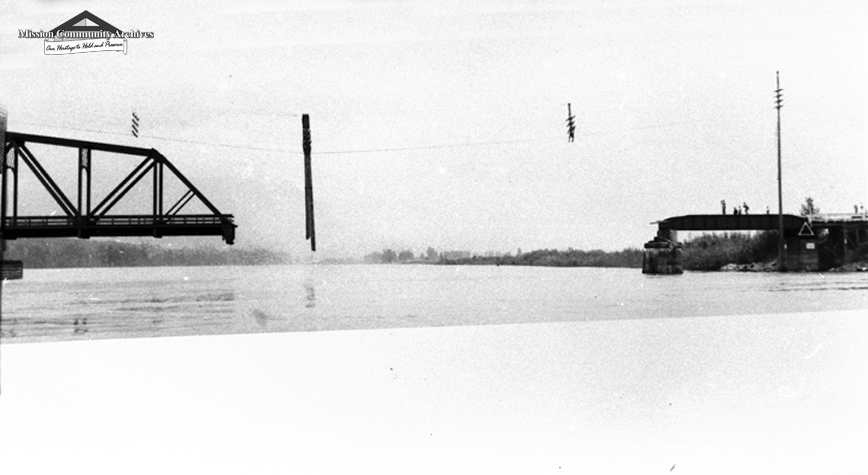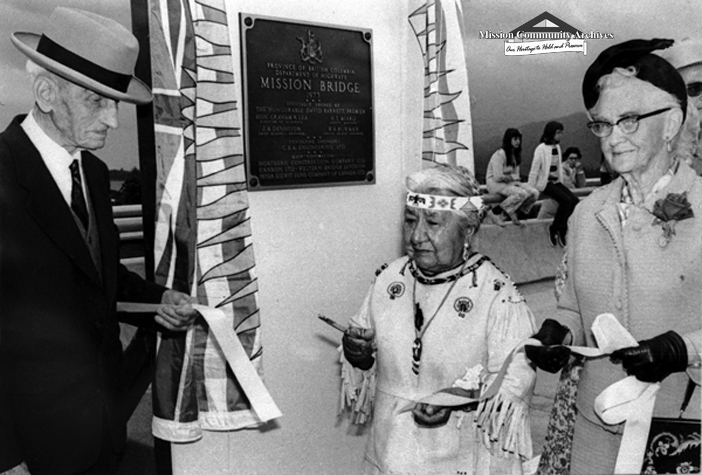The Story of the Mission Bridge
Bridge Beginnings
The iconic orange bridge that connects Mission to Abbotsford is a recent development in Mission’s infrastructure, built in 1973. Originally, the train bridge that is currently seated beside our “new” bridge connected Mission to the south side of the Fraser River.
The train bridge was first constructed and completed during the years of 1889-1891 by the CPR (Canadian Pacific Railway). The CP Rail construction crews worked from sunrise to sunset pounding in the twelve stone piers that would eventually support the bridge. The piers were sunk into the bottom of the river and set to hold nine linked wooden spans, including the swing span that could be raised to allow steamships and barges to pass safely underneath.
As Mission had a tendency to flood often, the building of the train bridge was a constant battle of the elements. Portions of the bridge had to be rebuilt daily because it would routinely sink into the boggy river bed.
Vehicles too?
In 1910, the news spread that the CPR had plans to replace the original wooden bridge with a steel one. The people of Mission requested that the bridge be re-planked so that it could also be open to wagon traffic, but the answer from the CPR was a resounding no. The City Board of Mission even offered to help raise the small amount of funds needed for the modifications on the bridge, but negotiation between the two parties broke down and the CPR put the idea of a bridge with vehicle access on hold indefinitely.
Seventeen long years later, on July 1st, 1927 the new bridge finally opened to all road traffic, allowing the citizens of Mission and Abbotsford to cross freely between the two cities.
The Collapse
On a Sunday morning in July of 1955, the Locken family was driving across the bridge when they felt it begin to “heave”. Another car, driven by Jim Sproule had just begun to cross, but screeched to a stop and hurriedly backed off the span. The Locken family raced their car to the South side just in time, as the bridge gave way and disappeared into the Fraser River.
Miraculously no one was hurt in the collapse, but the damage was felt for months to come. The bridge was Mission’s only reliable source of transport to and from the agricultural communities on the south side of the river, and at the time Mission was an important hub for both produce and dairy processing. Many residents on both sides were unable to get to their jobs and subsequently lost their positions. Business owners lost customers and town morale plummeted.
Rebuilding
The train bridge had never been properly designed to hold vehicular traffic, and Mission residents felt that they now deserved a proper bridge. But because the bridge belonged to the CP Rail, negotiations were opened and the process was incredibly slow, much to residents’ dismay. In November, roughly 4 months after the collapse, the CPR finally agreed to repair the existing bridge (refusing to build a new one) but predicted it would be yet another 6 months before traffic could be allowed to resume. Mission’s businesses were devastated at the news, and many feared bankruptcy would overtake them before the bridge would re-open.
Finally, in October 1956, a staggering 16 months after the collapse, the bridge was re-opened. Unfortunately, the damage had already been done. The South side customers and businesses had changed their consumer habits in the long absence, and Mission never quite regained its economic importance in the Fraser Valley.
A New Bridge
In 1973, the new bridge that had been promised was finally a reality! On July 7th, 1973, the years of frustration with the train bridge and its many issues were finally resolved with the opening of the new vehicle bridge.
The celebrations that took place at the opening of the new bridge consisted of many things. A lengthy parade traveled up and down the ceremonial platform and consisted of Mission’s elder residents driving their vintage vehicles. They were led by a Royal Canadian Mounted Police colour party and a large group of Matsqui police cruisers. 1,500 people attended the ceremony and looked onward as they followed the parade, keeping time with the several brass bands that bought up the rear. Jet planes that came from Air Command Comox flew above the crowd. Some jets flew low over the crowd as sky-divers descended down onto the platform. By four o’clock that day, ordinary traffic was just itching to be back on the bridge and zooming across it as if to make up for lost time.
But Mission’s challenges were not yet over: the impact of the collapse was still relevant even after the new bridge was built. Not only did the increase of business in Mission never arrive, as South side consumers’ new habits had become too firmly ingrained, but now Mission residents were using the bridge to take their business to Abbotsford. In the end, the new bridge had come twenty years too late, ultimately boosting the Abbotsford economy more than the town it was built for. Mission was no longer the destination it had once been.




